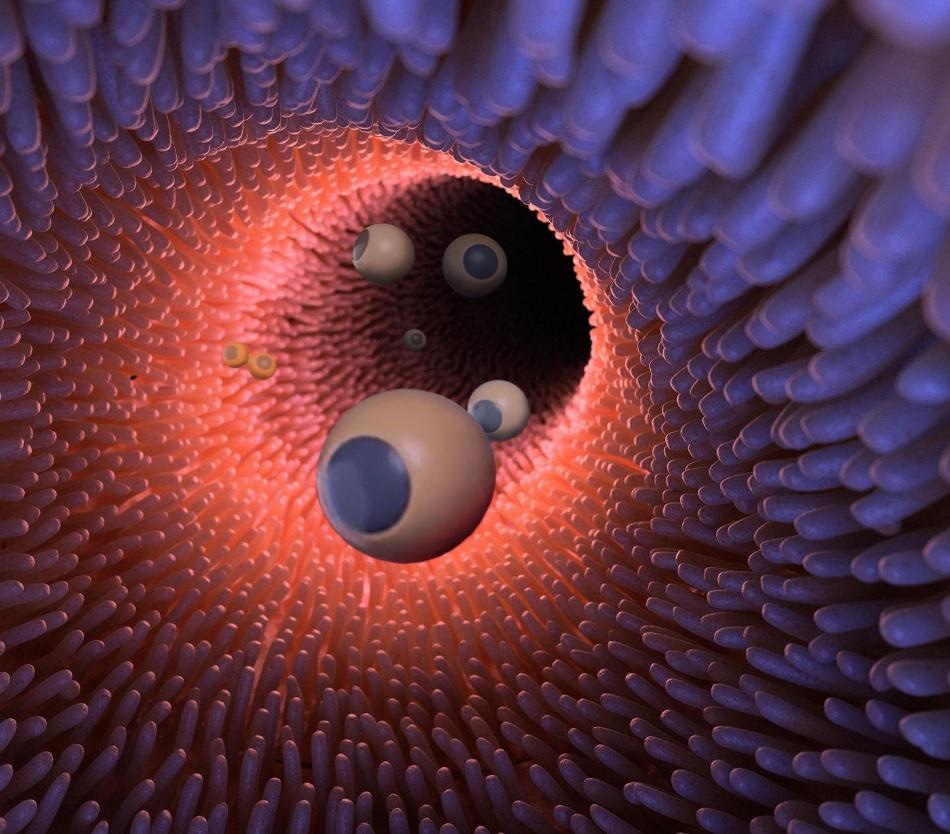Jul 25 2019
Targeted medical treatment is a practice that is as old as medicine itself. A broken arm is placed in a cast. A Band-Aid is used to cover a skinned knee. Drops are put into itchy eyes.
 An artist’s illustration of microrobots inside the gut. (Image credit – Caltech)
An artist’s illustration of microrobots inside the gut. (Image credit – Caltech)
But in many cases what ails the body within the body is not easily accessible. Then, a treatment like chemotherapy or surgery might be required. Two scientists in Caltech’s Division of Engineering and Applied Science are involved in a totally new form of treatment—microrobots that can deliver drugs to particular areas inside the body while being tracked and controlled from outside the body.
The microrobot concept is really cool because you can get micromachinery right to where you need it. It could be drug delivery, or a predesigned microsurgery.
Lihong Wang, Bren Professor of Medical Engineering and Electrical Engineering, Caltech
The microrobots are a collaborative research project of Wang and Wei Gao, assistant professor of medical engineering, and are meant for digestive tract tumor treatment.
The microrobots comprise microscopic spheres of magnesium metal coated with thin layers of gold and parylene, a polymer that endures digestion. The layers leave a circular area of the sphere uncovered, quite like a porthole. The uncovered portion of the magnesium reacts with the fluids in the digestive tract, producing small bubbles. The stream of bubbles behaves like a jet and pushes the sphere forward until it bumps into adjacent tissue.
Independently, magnesium spherical microrobots that can zoom around might be remarkable, but they are not particularly beneficial. To convert them from a novelty into a vehicle for transporting medication, Wang and Gao made a few alterations to them.
Primarily, a layer of medication is placed between an individual microsphere and its parylene coat. Next, to guard the microrobots against the extreme environment of the stomach, they are enclosed in microcapsules composed of paraffin wax.
At this stage, the spheres can transport drugs, but still, lack the vital ability to transport them to a preferred location. For that, Wang and Gao use photoacoustic computed tomography (PACT), a method formulated by Wang that uses pulses of infrared laser light.
The infrared laser light diffuses via tissues and is captured by oxygen-carrying hemoglobin molecules in red blood cells, causing the molecules to quiver ultrasonically. Those ultrasonic vibrations are sensed by sensors placed tightly on the skin. The data from those sensors is used to develop images of the body’s internal structures.
Earlier, Wang has demonstrated that differences in PACT can be used to recognize breast tumor, or even individual cancer cells. With regards to the microrobots, the method has two tasks. The first is imaging. By using PACT, the scientists can locate tumors in the digestive tract and also know where the microrobots are, which are displayed vividly in the PACT images.
When the microrobots reach the tumor’s vicinity, a high-power continuous-wave near-infrared laser beam is used to trigger them. Since the microrobots absorb the infrared light so strongly, they temporarily heat up, melting the wax capsule enclosing them, and exposing them to digestive fluids.
At that juncture, the microrobots’ bubble jets stimulate, and the microrobots start swarming. The jets are not maneuverable, so the method is kind of a shotgun method—the microrobots will not all reach the targeted area, but a lot would. When they do, they adhere to the surface and start discharging their medication cargo.
These micromotors can penetrate the mucus of the digestive tract and stay there for a long time. This improves medicine delivery. But because they're made of magnesium, they're biocompatible and biodegradable.
Wei Gao, Assistant Professor of Medical Engineering, Caltech
Tests in animal models reveal that the microrobots work as envisioned, but Gao and Wang say they are planning to push the research further.
We demonstrated the concept that you can reach the diseased area and activate the microrobots. The next step is evaluating the therapeutic effect of them.
Wei Gao, Assistant Professor of Medical Engineering, Caltech
Gao also states he would like to design variations of the microrobots that can work in other areas of the body, and with various kinds of propulsion systems.
Wang says his goal is to enhance how his PACT system networks with the microrobots. The infrared laser light it uses has a little difficulty accessing deeper areas of the body, but he says it should be possible to create a system that can go further.
The paper describing the microrobot research, titled, "A microrobotic system guided by photoacoustic tomography for targeted navigation in intestines in vivo," was published in the July 24th issue of Science Robotics. Other co-authors include Zhiguang Wu, Lei Li, Yiran Yang (MS '18), Yang Li, and So-Yoon Yang of Caltech; and Peng Hu of Washington University in St. Louis. The researchers received funding from the National Institutes of Health and Caltech’s Donna and Benjamin M. Rosen Bioengineering Center.
Laser-Activated Microrobots Deliver Drug Therapy
(Video credit: Caltech)